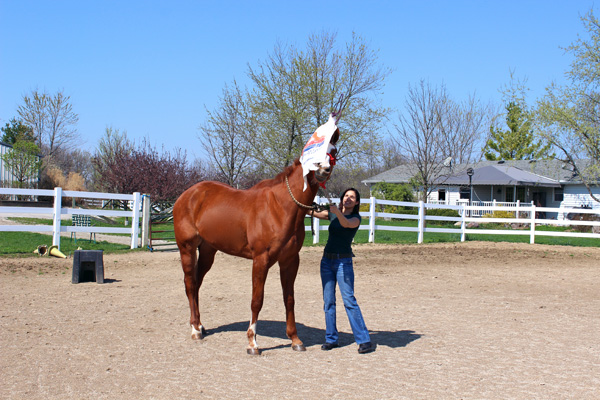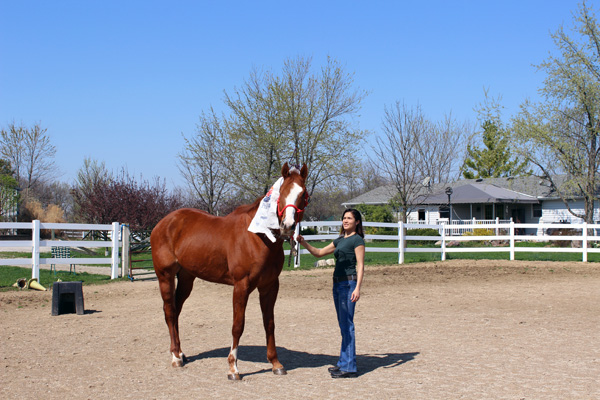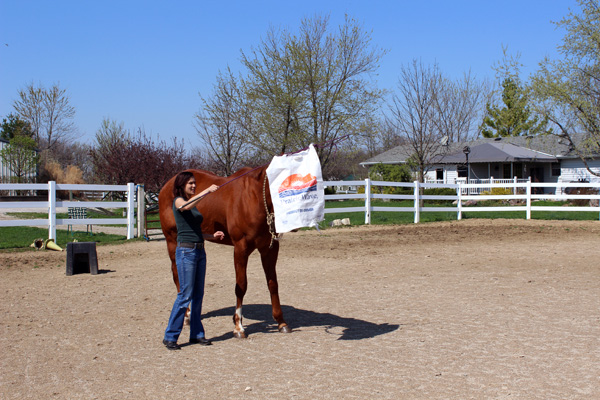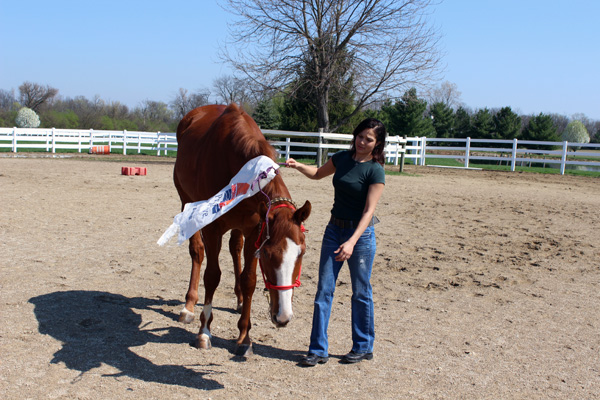Bombproofing Bahamut Part III
"It’s In The Bag." My horse training tips and desensitizing exercises.
An essential technique for retraining your ex-racehorse is "bombproofing," or "sacking out," which is a series of desensitizing exercises.
Working with my OTTB, off the track Thoroughbred, Bahamut is an adventure. I like to challenge him with various objects in different environments. My intention during these sessions, is for him to achieve a sense of stillness and confidence. The outcome should be a non-reaction to the situation presented.
This week didn’t present any major issues for Bahamut. The desensitizing I’ve been doing with him is starting to yield positive results, and I couldn’t be more pleased with him. He’s still playful by nature, but he's also transforming into a centered horse with a confident way of being.

Raina and Bahamut © Michelle Yaranga
I decided to work with a feed bag attached to a lunge whip in the outdoor arena. I wasn’t sure what his response would be when I started drawing it close to his body. There was no reaction when I began to lay it and drag it across his body.

Bahamut with feed bag being dragged over body ©Michelle Yaranga
So I continued on to the next step of dragging the bag towards his ears and over them. Again, no response. I praised him and gave him some sugar, as I was out of his favorite treats, peppermints. He gladly accepted the sugar, and we moved on.
I very slowly began to drag the bag over his ears, and then down over his face. His only response was trying to eat the bag. I guess it still smelled like feed, and he was hungry (again). While trying to eat the bag isn’t a flight response, it’s still unwanted behavior, even though it's funny. So, I raised my voice and sternly told him “NO.” He stopped trying to eat the bag, and I praised him with pats.

Feed bag dragged over neck © Michelle Yaranga
For the very last part of this exercise, since he was doing so well, I let go of his lead rope and flapped the bag around him. I brought the bag in closer to him and flapped it near his ears and finally in front of his face. Bahamut stood quietly and stoically. He was rewarded for his outstanding behavior, and we wrapped up the session. We always end on a positive note.

Feed bag being flagged in front of Bahamut's face ©Michelle Yaranga

Bahamut relaxed at the end of the session ©Michelle Yaranga
These sessions generally don’t take more than 20 minutes. It’s worth every minute investing this time into him. I’m very pleased with Bahamut’s progress, even though I don’t lay expectations on him. I hope you find something in the sharing of our experiences that will help you deepen the bond with your equine partner.
Be creative with what you use for your bombproofing exercises, there are many household or barn items that can be used:
- Feed bag or grocery store bags tied to whip
- Aluminum cans filled with rocks
- Yoga ball
- Tarp
- Rain jacket
- Bicycle
- Car alarm
- Trash can
Here are some tips for desensitizing:
- Start with simple objects
- Work in an enclosed area
- Move slowly
- Be gentle
- Repeat process until no reaction
- Praise and reward
These horsemen have some great training techniques for horses and equestrians of any level:
JulieGoodnight.com Julie Goodnight
Downunderhorsemanship.com Clinton Anderson
Johnlyons.mybigcommerce.com John Lyons
Parellinaturalhorsetraining.com Parelli
Montyroberts.com Monty Roberts
Infohorse.com Ed Thornton
Here are some books I'm reading concerning "Bombproofing" horses and horsemanship:
The Art of Horsemanship by Xenophon
Bombproof Your Horse by SGT. Rick Pelicano and Lauren Tjaden
Better Than Bombproof by SGT. Rick Pelicano and Eliza McGraw
Considering adopting your own ex-racehorse? Here are some great rescue organizations with horses looking for their new home:
Read Part 1 and Part 2 of Bombproofing Bahamut
About the Author: Raina Paucar is an adventure loving equestrian and female jockey. She likes to ride and compete in many disciplines, explore new places, read great books, gadget hoard, play games, take pictures and write. She currently exercises racehorses and works with her own off-the-track-Thoroughbred (OTTB). Her career in media focuses on equestrian lifestyle. You can add her to your Google+ circles, subscribe on Facebook and follow on Twitter.




